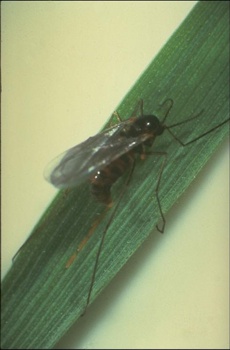Pests
Mayetiola destructor Say - Hessian Fly.
Systematic position.
Class Insecta, order Diptera, family Cecidomyiidae, genus Mayetiola.Biological group.
Oligophagous cereal pests.Morphology and biology.
Imago 2.5-3.5 mm; body dark gray or red-brown, females with red-brown spots on abdomen. Head small, eyes dark. Antennae ocherous. Mouth parts underdeveloped. Thorax black, with pink lateral stripes. Legs long, slender. Female abdomen ovoid, pointed at apex, male abdomen with forcipate sexual appendages. Female lives 5-7 days and lays on the average 40-250 (maximum 500) eggs, mainly on the upper side of leaves, in a series with several eggs in a line. Eggs reddish-brown, cylindrical. Duration of egg development is 5 to 10 days. Larvae develop on winter wheat during the whole period of vegetation. The autumn generation develops on shoots, spring generation on plants in stages of booting to the beginning of ear emergence. The summer generation develops in the period of dough development. Larva migrate to leaf sheaths, stick to base of stalks on young plants, later in internodes. Duration of larval stage is 15 to 30 days. Prepupa is located within puparium formed of larval cuticle. The prepupa transforms into pupa in 2 weeks during damp weather. Larvae of spring and summer generations diapause under adverse weather conditions. They overwinter in puparia on winter shoots, fallen grain and wild cereals.Distribution.
Occurs in Europe, Northern Africa, Northern America, New Zealand, Central Asia, Ukraine, and Transcaucasia. In Russia it is widely distributed in the European part (except for the Far North), in the northern Caucasus and Siberia.Ecology.
Two or three generations develop in the major area of distribution, four or five in the south. Imagoes start to fly when daily average air temperature are between 10 to 12°C in spring, and perish in 2 or 3 days. Temperatures 16 to 20°C are necessary for normal development of all stages. The eggs and hatched larvae perish at temperatures higher than 24°C and at frosts. Flies of the 1st (spring) generation appear during the booting of winter cereals, lasting 30 to 40 days. High temperatures in combination with low air humidity and winds suppress development of the pest. Entomophages (predators and parasites) also reduce its number.Economic significance.
The greatest damage is to winter and spring wheat, rye, barley; the species avoids oats. Also develops on wild (Elytrigia repens, Poa sp.) and cultivated cereal grasses (Elytrigia tenerum, Elymus sibiricus, Roegneria fibrosa, Eremopyum sp., Bromus inermis). Control measures include maintenance of crop rotations (excluding grain crops after cereal predecessors); removing stubble, deep early autumn plowing before winter cereals sprout; eradication of Elytrigia weeds.Related references:
Belyaev I.M. 1974. Pests of grain crops. Moscow: Kolos. 284 pp. (In Russian)Kryshtal' A.F. 1974. Cecidomyiidae. In: V.P. Vasil'ev, ed. Pests of agricultural crops and forest plantations. Arthropods. Kiev: Urozhai. V. 2: 499-519. (In Russian)
Mamaeva Kh.P., Mamaev B.M. 1981. Cecidomyiidae. In: Narchuk E.P., Tryapitsyn V.A., editors. Insects and mites-pests of agricultural plants. Hymenoptera and Diptera. Leningrad: Nauka. V. 4: 68-98. (In Russian)
Pavlov I.F. 1983. Field crops protection from pests. Moscow: Rossel'khozizdat. 224 pp. (In Russian)
Polyakov I.Ya., ed. 1973. Methods of survey and forecasting of the development of plant pests and diseases in Central Black Earth Strip. Voronezh: Kommuna. 100 pp. (In Russian)
Zagovora A.V. 1962. About some features of Hessian Fly reproduction in Ukraine. In: Questions of the Ecology of Territorial Invertebrates. Proceedings of 4th Ecological Conference(abstracts). Moscow: Vysshaya shkola. V. 7: 61-62. (In Russian)


